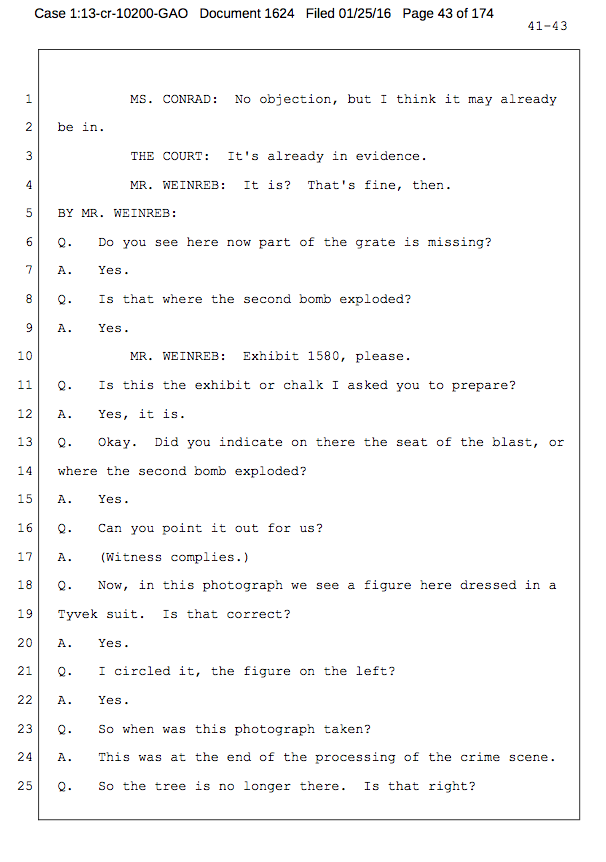Part 1 - the nitroglycerin-contaminated soup can lid
I can’t believe we are excluding explosives as expertise in this case - with this exclamation Judy Clarke protested the lack of interest on behalf of the prosecution for the nature of the explosives used in the Boston bombings at a pre-trial status conference in June 2014. The prosecution complied with her request and summoned David McCollam as an expert, a "chemic forensic examiner assigned to the Explosives Unit" of the FBI. He testified on March 26, 2015. You can download his statement here.
After talking about his career, credentials, and current job McCollam is asked to explain explosives in general. He makes a distinction between high explosives, like TNT, C4, dynamite or nitroglycerin, and low explosives like black powder or, notably, smokeless powder - we'll come to that later. He explains that low explosives have a detonation velocity below the speed of sound, whereas the velocity of high explosives is much higher than that mark.
He is then asked what residues of explosives the FBI found at Boylston Street and in Watertown and states that it was "low-explosive, pyrotechnical, firework-type material", i.e. the black powder type. He doesn't say if any other explosives, like smokeless powder or high explosives, were found at the bomb sites, and he's not asked for that - we'll also come to that later.
He is then asked if traces of the low explosive used at the Marathon were found in the Norfolk Street appartment, which he confirms.
In the cross-examinaton defense lawyer Timothy Watkins first asks him for some places where the black powder was found, like gloves etc. After that, he introduces a FBI photo showing the content of a drawer in the Norfolk appartment, concentrating on a lid detached from a soup can with an adhering black substance. And now the testimony takes a surprising twist:
For the first time the public here learns of high explosives in relation to the bombings - and it is the defense bringing the subject on the table, not the prosecution! Another one of these weird moments at the trial - what is happening?
A second look reveals that Watkins has established a contradiction between McCollam's statement in the direct examination - that smokeless powder belongs to the class of low explosives - and what he admits here, i.e. that nitroglycerin, a high explosive, is part of a "double-based smokeless powder". A little research reveals quickly that the "double based" is crucial:
From the aspect of the bomb technician, it is most important to understand that a single-based smokeless powder will only function as a low explosive. However, double and triple based smokeless powders may function as a high explosve, by initiating them with a detonator rather than a heat source. If used in this manner, they may achieve a velocity of detonation (VOD) of approximately 15000 ft/s, similar to dynamite.Watkins doesn't go deeper into the subject. It is all the more interesting that the day before Miriam Conrad already showed a similarly keen interest in the can lid during the cross-examination of Christopher Derks, a FBI agent who participated in the search of the Norfolk appartment:
Paul L. Laska: Bombs, IEDs, and Explosives
This raises some interesting questions:
Why did the prosecution ignore this piece of evidence?
Why was the defense eager to pick it up instead?
Why did McCollam classify smokeless powder as a low-explosive in the initial examination when in fact it might belong to both of the categories, depending on the composition - especially as a high-explosive variant was found in Tamerlan Tsarnaev's home?
A fourth question may help to solve this riddle: has this nitroglycerin/ethyl centralite substance, the high-explosive double-based smokeless powder, been found at the bomb sites?
The fact that McCollam testifies that "low-explosive pyrotechnic material" was found at Boylston Street doesn't mean that no residues of high-explosives were found. He is not being asked for and doesn't explicitly exclude it. It appears that he knows that smokeless powder was found there, but fiddles around with its high-explosive nature to downplay its significance and the possibility that there were different bombs involved - other than the firework-powder filled backpacks of the Tsarnaevs. But Watkins doesn't let him get away with this play.
It should be noted that in the first reports after the bombings smokeless powder was mentioned as a probable explosive, alongside black powder (Daily Mail, NBC, and others).
Dzhokhar Tsarnaev's bag was not the black nylon backpack the FBI initially searched for. Video footage shows that his bag didn't contain a pressure cooker. I have argued on this blog that it was impossibly the epicenter of the second bomb. The nature of the "real" bomb seems to become increasingly clear: most probably it was a pressure cooker filled with high-explosive smokeless powder based on nitroglycerin, contained in a black backpack, and exploding on the patio of the Forum restaurant.
Does the can lid in the Norfolk appartment prove that the Tsarnaevs were involved in the "real" high-explosive bombs? No, not at all. It might have been planted there by the same people who want to make the Tsarnaevs the patsies for the Boston bombings. The prosecution has provided no evidence that the brothers acquired smokeless powder on any occasion.
In the next blog entry - Part 2 - I will deal with the question if the black powder that was presumably inside the Tsarnaev bags would have been able to have the devastating effect of the Marathon bombs.






















































